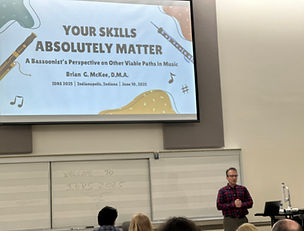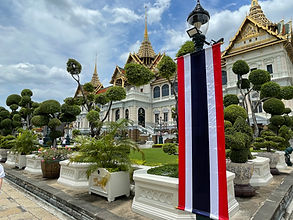
Brian G. McKee, D.M.A.
Bassoonist | Educator | Ensemble Performer | Recitals | Reed Making | Ensemble Coaching
IDRS Indianapolis 2025



IDRS 2025 took place at Butler University in Indianapolis, Indiana. This year, I presented a lecture-presentation on my latest research interest highlighting transferrable skills that young musicians learn as students and how they can be applied to different areas as their aspirations develop. In my presentation, entitled "Your Skills Absolutely Matter: A Bassoonist’s Perspective on Other Viable Paths in Music," I cited my experiences working in university student services and in the nonprofit sector as a program director and operations manager for different youth orchestras.
I attributed my skills and experiences to my training as a bassoonist and gave examples such as mechanical knowledge of the instrument, reed making methodology, and rehearsal techniques and ensemble leadership experiences as skills that are very practically applied in my current administrative and operations positions which helped me develop skills that I continue to utilize in my career projects and pursuits. I also advocated for those who may be in similar positions of exploring other viable paths in music while refining previously acquired performance skills.
I am grateful to those who attended and took interest in my topic, including bassoonists, oboists, composers, educators, conductors, students, and other enthusiasts who asked great questions and offered wonderful feedback about the experiences of using skills acquired in their musical upbringings in their different career paths.
IDRS Flagstaff (AZ) 2024
The 2024 International Double Reed Society Conference took place at Northern Arizona University in Flagstaff, Arizona. It was my first return to Arizona since completing my M.M. in 2014. I performed a recital entitled "A Bassoonist's Scrapbook: Snapshots of Places We Call Home." The program featured works that shaped me as a person and as a musician, and reflected the common experience of musicians moving from place to place wherever they find work. As musicians, we often build our communities and find a sense of place and belonging based on our craft, and though we often move to wherever we can find opportunities, we also have an overwhelming desire to settle in one place, invest in the place we call home, and be a part of something. Having spent time living in cities all over the country, I first encountered each of the works I performed on this recital in a different place, and all of them represent a snapshot of a place I have called home. The composers are my friends and colleagues who made significant impressions on me. I am eternally grateful for their friendship and willingness to collaborate, and the experience of working with them is something that I will always treasure.



IDRS Thailand 2023
July 2023: I traveled to Bangkok, Thailand to perform a short recital of Latin American music at the 2023 International Double Reed Society Conference at Mahidol University. Our recital was called "Canciones Reinventadas: Latin American Chamber Music Reimagined for Bassoon." It was an honor to perform amongst a lineup of fantastic musicians from all over the world on this beautiful campus in Southeast Asia. I performed three Venezuelan waltzes originally for solo guitar by Antonio Lauro, later adapted for bassoon by Paquito D'Rivera, as well as three additional works with my wife and violinist Diana Ramírez Rosales: El día qua me quiras by Alfredo le Pera/Carlos Gardel (arr. Maricel Mendez), the premiere performance of Sonatina para violin y fagot by Costa Rican composer Sergio Delgado, and an arrangement of Astor Piazzolla's Primavera Porteña for violin, bassoon, and piano. We had a lovely time making music, reconnecting with friends, colleagues, and former teachers, and doing a bit of sightseeing between activities. We absolutely loved Thailand and can't wait to come back!



Conducting Projects
I have recently taken an interest in ensemble conducting. I have had several opportunities to conduct student ensembles in rehearsals and in special event performances. The videos below are excerpts from recent concerts and dress rehearsals. I enjoy conducting and I treat it as a newly-discovered perspective of teaching and music leadership. Working with a youth orchestra has been a perfect medium to sharpen and develop my teaching and ensemble coaching skills.
Music from Pirates of the Caribbean - Badelt arr. Moore - Monterey Symphony Opener Dress Rehearsal
Tchaikovsky – March of the Tin Soldiers, Mozart – Marcha alla Turka, Tchaikovsky – Polka, Mozart – Eine Kleine Nachtmusik (from YOSAL-Youth Orchestra Salinas 2022 Spring Concert)

W.A. Mozart - Concerto for Bassoon and Orchestra, K. 191 - Cadenza Project
I have arranged two short cadenzas, one for each of the first two movements of Mozart's Bassoon Concerto in B-flat major, K. 191. Each cadenza is available for free download in PDF format below, along with a short video demonstrating each of the cadenzas. Please feel free to view scores, and if you like them and happen to incorporate them into your next performance of the Concerto, I would love to hear about it. After many months I am excited to finally make this project a reality!
Cadenza no. 1 - Allegro (mm. 160-161) (2019)
The first theme of this cadenza begins with a melodically-extended version of the opening bassoon solo motive (mm. 35-38). It then hints at a familiar motive found toward the end of the first movement of a different Mozart chamber work for bassoon, the Duo Sonata, K. 292. Then, it quotes a portion of another motive first played by the violins in the introduction of the Concerto (mm. 11-13), this time in a minor key. Continuing with this rhythm, it then moves through a variety of sequences before a series of scales in the instrument's lowest register indicate the coming of the final cadence, ending on a trill from the third octave A to B-flat instead of the traditional C to B-flat. The tempos in the cadenza should be steady, yet also interpreted freely, at the discretion of the performer. Long notes should be held well beyond their indicated durations, and sixteenth note passages at the ends of phrases can be temporally altered as musically applicable. Rests can be used as artful pauses between thematic sections. Take your time through each of these sections, as you are the sole musical voice and are in total control before the conductor or ensemble cues the final coda at the arrival of the final B-flat in m. 161.
Cadenza no. 2 - Andante ma adagio (mm. 49-50) (2019)
This cadenza melodically begins with the same motive and rhythm that the strings play together in m. 48, before the arrival of the cadential VI-IV chord. This continues for several measures more before moving to another theme originally played by the violins in the movement's introduction, leading to a developmental sequence moving through the bassoon's tenor register. The performer then quotes a passage originally played by the oboes in m. 14 and later by the solo bassoon in m. 38, though this time in a different register and in a minor key. It then moves to an inventive melodic sequence, starting in the bassoon's middle register and moving upward before the arrival on the held "Rite of Spring" high C in the third octave. Similar to the previous cadenza, it ends by trilling upward between tenor E and F, instead of the traditional downward trill from A to G to F at the final cadence. In this cadenza, along with the previous, treat each of the lyrical sections like a gentle opera aria (think of the original second movement melodic material that comes from the aria "Porgi, Amor" in Le Nozze di Figaro). Tempos, phrase direction, and cadences are left much to the performer's interpretation where applicable. It should not be rushed, and indicated rests can again be treated as artful pauses.
Reed Diagram Handout